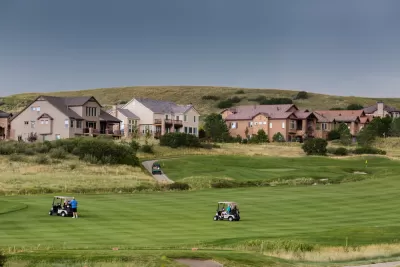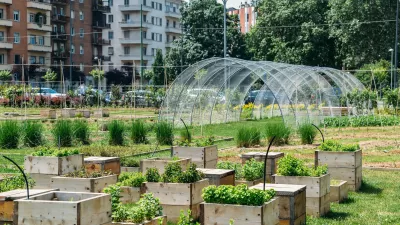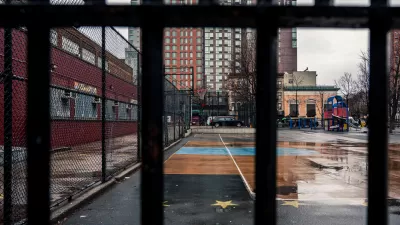Environmental impact isn't just a measure of what people buy, where we live affects the environment more than what we own or choose to drive.

In a consumerist society, it's easy to focus too intently on the environmental impact of possessions, when the location where we choose to live, work or play has a bigger, though less-discussed, impact on our lives and our footprints, both physical and carbon. Where we live affects the environment more than what we own or choose to drive.
Jeff Speck calls out this phenomenon in his book, Walkable City, in a section called "Missing the Forest for the Trees."
"It turns out trading all your incandescent lights for energy savers conserves as much carbon per year as living in a walkable neighborhood does each week. Why then, is the vast majority of our national conversation about the former, not the latter?"
Though this distinction is well understood by planners, it’s a foreign concept to the average citizen or politician. Since many people care about the environment and are willing to act on its behalf, this comparison can serve as a convincing rationale for investment in cities. As much as people care, they don't understand which choices benefit the environment and which simply waste time. It's a vitally important question, but a difficult one to untangle. If I buy a hybrid car, for instance, instead of driving my older car, have I helped the environment by using less gasoline and putting less carbon in the air? Or have I created more demand for a complex machine that consumes masses of natural resources?
Where we live determines how we get to where we're going. Not only the length of these trips, but the mode of transit. Less dense neighborhoods have fewer options for getting around without the use of cars: from bike lanes, to buses, to sidewalks.
If you live in a walkable neighborhood, the things you and your peers will have access to for fun are likely to be less environmentally harmful. The variety of "third places," restaurants, and cultural sites gives us more ways to entertain ourselves without fencing off huge tracts of land for a chosen few. A country club with a golf course, for instance, eats up green space, water, and energy to entertain a small, affluent group. A walk to the park or window-shopping in a trendy neighborhood is effectively resource-free.
Lawn grass is the number one crop produced in America, far outstripping corn or soybeans in acreage and land use. Lawns are a way to make greenspace private rather than shared. When everyone has their own personal natural space, resources are divided and used less efficiently. Lawns consume great amounts of water, topsoil, fertilizers, pallets, and the mowers to maintain them are extremely heavy and, therefore, resource-intensive to transport. Zoning for lawns increases distances between resources and fills cities with more cars.
Even the layout of the streets can change the environmental impact of neighborhood. A cul-de-sac is less flexible than a grid street pattern because it is built not for ease of access but for intentional isolation. If you live in one you cannot move by the most efficient means. Another deterrent to walkability is oversized blocks that make neighborhoods more difficult and less interesting to navigate in any vehicle slower than a car.
This is not to glorify the grid. Grids come with their own set of problems (sameness and boringness, perhaps, chief among them) but their greatest strength is flexibility. It's difficult to redevelop homes built in single use cul-de-sacs. The value of homes in those neighborhoods comes back more slowly from recession, which also creates an ecological impact. Houses and businesses that get repaired, that maintain their use for longer are necessarily green, because they reduce the need to manufacture and transport building materials.
Distribution centers offer another efficiency inherent to cities by providing natural distribution hubs for food, goods, and materials. Distribution centers make building in a city more efficient than building in sprawl. Many resources are already available nearby, and there's minimal additional environmental cost to deliver them to the construction site.
Beyond goods, there's also a cost to distributing services over distances. Firefighting, police, and utilities like internet, phone, electrical, and sewage become more resource-intense as the miles they have to cover increase. And building these services and utilities only represents one aspect of the problem. Their maintenance is also more draining. Consider how vulnerable a telephone poll is to storms on a nearly empty highway compared to telephone lines that run through a city center. Imagine how much more vulnerable a school is to a flood when the school depends on the drainage system of a small town. Think of the logistical challenges of fixing power grid problems and how the challenges increase as the population resides further from centers of expertise. Think of how much farther the people who solve these problems have to travel.
Where we decide to live produces a powerful butterfly effect. This one choice creates a big change in our environmental impact. We won't buy our way to sustainability with gadgets. We will have to live in a world with more built-in sustainability—and that means more walking, more proximity and more efficiency in where we buy and rent our homes.

Alabama: Trump Terminates Settlements for Black Communities Harmed By Raw Sewage
Trump deemed the landmark civil rights agreement “illegal DEI and environmental justice policy.”

Study: Maui’s Plan to Convert Vacation Rentals to Long-Term Housing Could Cause Nearly $1 Billion Economic Loss
The plan would reduce visitor accommodation by 25% resulting in 1,900 jobs lost.

Why Should We Subsidize Public Transportation?
Many public transit agencies face financial stress due to rising costs, declining fare revenue, and declining subsidies. Transit advocates must provide a strong business case for increasing public transit funding.

Paris Bike Boom Leads to Steep Drop in Air Pollution
The French city’s air quality has improved dramatically in the past 20 years, coinciding with a growth in cycling.

Why Housing Costs More to Build in California Than in Texas
Hard costs like labor and materials combined with ‘soft’ costs such as permitting make building in the San Francisco Bay Area almost three times as costly as in Texas cities.

San Diego County Sees a Rise in Urban Coyotes
San Diego County experiences a rise in urban coyotes, as sightings become prevalent throughout its urban neighbourhoods and surrounding areas.
Urban Design for Planners 1: Software Tools
This six-course series explores essential urban design concepts using open source software and equips planners with the tools they need to participate fully in the urban design process.
Planning for Universal Design
Learn the tools for implementing Universal Design in planning regulations.
Smith Gee Studio
Alamo Area Metropolitan Planning Organization
City of Santa Clarita
Institute for Housing and Urban Development Studies (IHS)
City of Grandview
Harvard GSD Executive Education
Toledo-Lucas County Plan Commissions
Salt Lake City
NYU Wagner Graduate School of Public Service






























